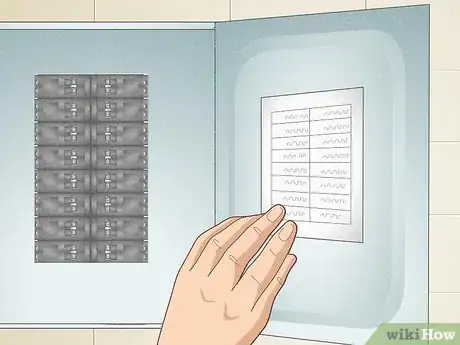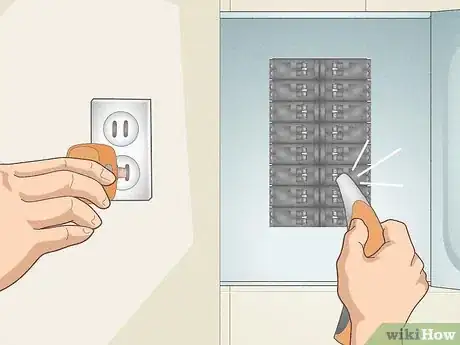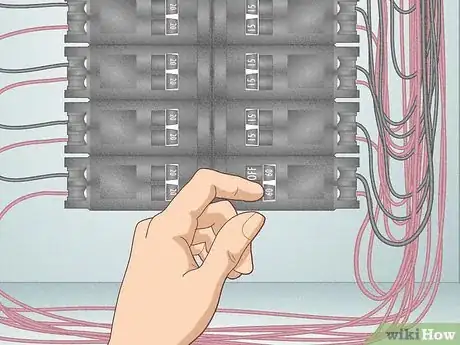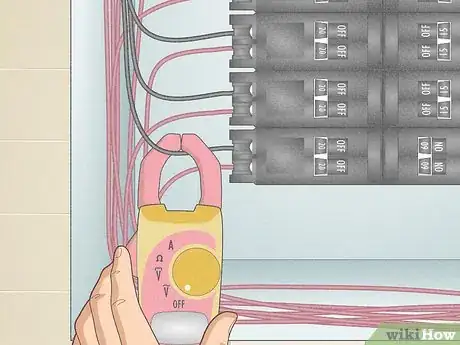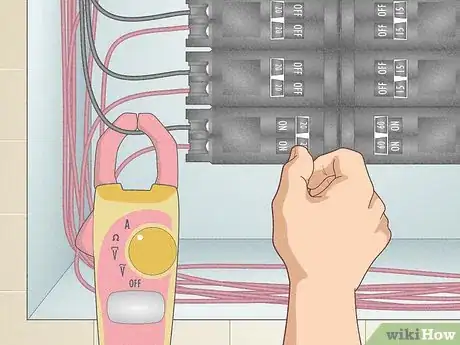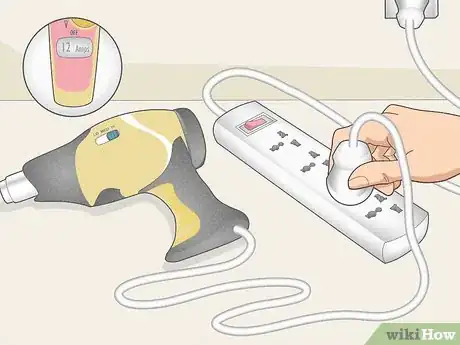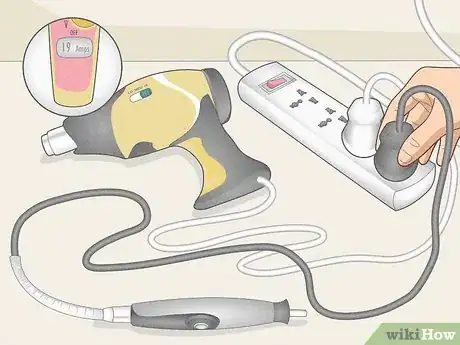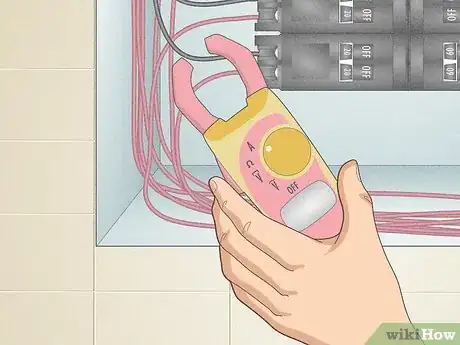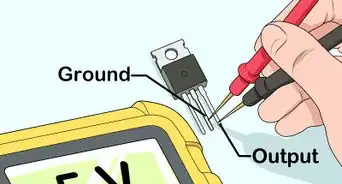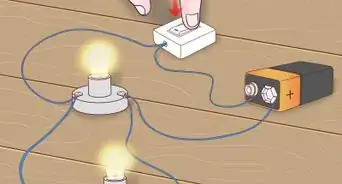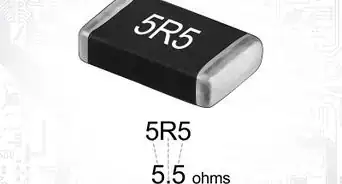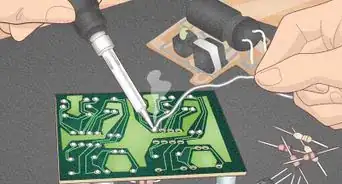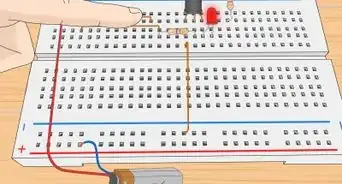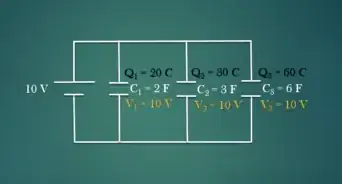This article was co-authored by Jesse Kuhlman and by wikiHow staff writer, Janice Tieperman. Jesse Kuhlman is a Master Electrician and the Owner of Kuhlman Electrician Services based in Massachusetts. Jesse specializes in all aspects of home/residential wiring, troubleshooting, generator installation, and WiFi thermostats. Jesse is also the author of four eBooks on home wiring including "Residential Electrical Troubleshooting" which covers basic electrical troubleshooting in residential homes.
There are 11 references cited in this article, which can be found at the bottom of the page.
This article has been viewed 62,511 times.
Figuring out your home electricity system can be confusing, especially if you’re trying to figure out how much electrical current, or amperage, runs through a specific outlet. While individual circuits are labeled with their amp limit, it may help to check the individual amperage of different devices so you know how much your outlet can handle. Before you dive into this project, think about your personal comfort levels when it comes to your home’s electricity. Working with wiring can be dangerous if you don’t have a lot of experience, so you may want to contact a professional for help.
Steps
Examining the Circuit Breaker
-
1Read the circuit label to see the amp level. Look at the individual circuits in the breaker box and search for a label. Note that most home circuits are labelled with “15” or “20,” since that’s the traditional electrical current level that’s safe to travel through most circuits. Take note of how much power your circuits can handle before you get started, so you have an idea of what you’re working with.[1]
- For instance, a 20-amp circuit can handle more electricity than a 15-amp circuit.
- Some wiring systems may include both 15-amp and 20-amp circuits.
-
2Check which circuits line up with specific outlets. Look at the inner door of your circuit breaker and see if there’s a chart or labeling system that specifies which circuits go with which outlets. Note that different groups of circuits power different outlets in your home, like the outlet for your dryer.[2]
- These charts can be confusing, so don’t be discouraged if you can’t figure out which circuit matches with which outlet.
Advertisement -
3Test your circuits with a circuit breaker finder if you don’t have a chart. Plug 1 part of the circuit breaker finder into the outlet you’d like to test, then drag the other part of the circuit breaker finder down the circuit breaker. Once this tool beeps, you’ll know which breaker corresponds with the outlet.[3]
- You can purchase a circuit breaker finder at your local home improvement store.
- Double-check all of the circuits with the circuit breaker finder to make sure you’ve found the correct outlet.
Checking an Outlet Circuit
-
1Turn off your circuit breaker completely. Find where the circuit breaker is in your home. You may need to remove a few screws so you can access the individual circuits. For your own safety, flip your circuits to the “off” position so you don’t risk giving yourself a shock.[4]
- If you know which circuit you’ll be working with, just turn off that specific circuit instead.
- Most of the wiring for your home is managed and controlled through a large metal box, or circuit breaker. This box may be in your basement or some other part of your home. If you aren’t completely sure, double-check your home’s schematics for guidance.
-
2Attach an ammeter or multimeter clamp to the designated circuit wire. Find a multimeter (device that measures multiple settings) or ammeter (device that specifically measures amperage) with a claw-like clamp that can clip onto things. Take this clamp and attach it to the wire coming out of the designated circuit that you’d like to test.[5]
- Double-check that you’re attaching the multimeter or ammeter to the correct wire, or else your readings may be off.
- You can attach your multimeter or ammeter to the circuit wire while your circuit breaker, but this is very risky if you’re inexperienced.
-
3Set your device to the “amp” setting. Check that your multimeter or ammeter is set to amps, which will be marked by an “A,” or something similar. If your device isn’t set to the correct setting, the readings won’t be very helpful.[6]
-
4Switch the outlet circuit on so power is flowing. Flip the switch connected to your designated outlet so power flows through the wire and through your multimeter or ammeter. You may see the reading on your device alter slightly after you turn on the circuit breaker, which is normal.[7]
- If you don’t feel comfortable working with live electricity at its source, call an electrician or repair professional for help.
-
5Connect a surge protecting strip into the outlet that you’re testing. Find the outlet that you’d like to test and plug a surge protecting power strip into the socket. This strip will help you measure the amperage of multiple devices, and will also protect your devices from electrical surges.[8]
- If you’re only testing 1 item, you may not need to worry about using a power strip.
- You can find power strips at most places that sell electronics.
-
6Plug 1 item into the power strip and see how many amps it draws. Check the multimeter or ammeter to see what the reading is. Keep in mind that certain devices will require more amperage than others.[9]
- For instance, a garbage disposal may only register as 4 amps, while a heat gun set to high may register as 12 amps.
-
7Add an additional item to the power strip and watch the amp level. Check the multimeter or ammeter and see what the reading is. Keep your circuit’s total amp level in mind as you add different appliances so you don’t overload your circuit.[10]
- For example, you likely wouldn’t be able to plug your microwave, refrigerator, and dishwasher all into the same outlet.
-
8Disconnect the ammeter once you’ve finished testing. Unclip the device from the circuit wire so you can get your circuit breaker back to the way it was before. Store it someplace nearby in case you want to test any of your circuits again.
-
9Contact an electrician if there are any issues with your outlet amperage. Call a professional if anything seems weird or finicky with your wiring. Don’t try to fix it yourself—wiring systems are really dangerous, and you can get hurt if you don’t know what you’re doing.[11]
Expert Q&A
Did you know you can get expert answers for this article?
Unlock expert answers by supporting wikiHow
-
QuestionHow do you determine if an outlet is grounded?
 Jesse KuhlmanJesse Kuhlman is a Master Electrician and the Owner of Kuhlman Electrician Services based in Massachusetts. Jesse specializes in all aspects of home/residential wiring, troubleshooting, generator installation, and WiFi thermostats. Jesse is also the author of four eBooks on home wiring including "Residential Electrical Troubleshooting" which covers basic electrical troubleshooting in residential homes.
Jesse KuhlmanJesse Kuhlman is a Master Electrician and the Owner of Kuhlman Electrician Services based in Massachusetts. Jesse specializes in all aspects of home/residential wiring, troubleshooting, generator installation, and WiFi thermostats. Jesse is also the author of four eBooks on home wiring including "Residential Electrical Troubleshooting" which covers basic electrical troubleshooting in residential homes.
Master Electrician
-
QuestionWhat is a GFCI receptacle?
 Jesse KuhlmanJesse Kuhlman is a Master Electrician and the Owner of Kuhlman Electrician Services based in Massachusetts. Jesse specializes in all aspects of home/residential wiring, troubleshooting, generator installation, and WiFi thermostats. Jesse is also the author of four eBooks on home wiring including "Residential Electrical Troubleshooting" which covers basic electrical troubleshooting in residential homes.
Jesse KuhlmanJesse Kuhlman is a Master Electrician and the Owner of Kuhlman Electrician Services based in Massachusetts. Jesse specializes in all aspects of home/residential wiring, troubleshooting, generator installation, and WiFi thermostats. Jesse is also the author of four eBooks on home wiring including "Residential Electrical Troubleshooting" which covers basic electrical troubleshooting in residential homes.
Master Electrician If you have a newer outlet, it should have a little reset button on it. That's a GFCI receptacle. It basically protects you from being shocked. Pressing that will basically pause the amperage coming into the outlet. The GFCI may trip automatically if there's something wrong with the wiring in your home.
If you have a newer outlet, it should have a little reset button on it. That's a GFCI receptacle. It basically protects you from being shocked. Pressing that will basically pause the amperage coming into the outlet. The GFCI may trip automatically if there's something wrong with the wiring in your home. -
QuestionWhat's the difference between a two-prong and three-prong outlet?
 Jesse KuhlmanJesse Kuhlman is a Master Electrician and the Owner of Kuhlman Electrician Services based in Massachusetts. Jesse specializes in all aspects of home/residential wiring, troubleshooting, generator installation, and WiFi thermostats. Jesse is also the author of four eBooks on home wiring including "Residential Electrical Troubleshooting" which covers basic electrical troubleshooting in residential homes.
Jesse KuhlmanJesse Kuhlman is a Master Electrician and the Owner of Kuhlman Electrician Services based in Massachusetts. Jesse specializes in all aspects of home/residential wiring, troubleshooting, generator installation, and WiFi thermostats. Jesse is also the author of four eBooks on home wiring including "Residential Electrical Troubleshooting" which covers basic electrical troubleshooting in residential homes.
Master Electrician
Warnings
- If you ever feel uncomfortable or unsure of something, call a professional for help. The circuitry and wiring of your home can be very dangerous, and you shouldn’t mess around with it unless you have a lot of experience.[12]⧼thumbs_response⧽
Things You’ll Need
Examining the Circuit Breaker
- Circuit breaker finder
Checking an Outlet Circuit
- Multimeter or ammeter
- Surge protecting strip
References
- ↑ https://m.youtube.com/watch?v=C90xtD6JoQA&t=0m31s
- ↑ https://m.youtube.com/watch?v=PFtjuvooJzk&t=2m12s
- ↑ https://m.youtube.com/watch?v=hxz6cCP3EbI&t=2m20s
- ↑ https://www.popularmechanics.com/home/interior-projects/how-to/a20609/how-to-avoid-electrical-shock/
- ↑ https://m.youtube.com/watch?v=0ODdPUGIZ1Q&t=3m20s
- ↑ https://m.youtube.com/watch?v=C90xtD6JoQA&t=1m4s
- ↑ https://m.youtube.com/watch?v=0ODdPUGIZ1Q&t=3m33s
- ↑ https://m.youtube.com/watch?v=C90xtD6JoQA&t=2m22s
- ↑ https://m.youtube.com/watch?v=C90xtD6JoQA&t=1m9s

